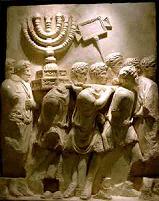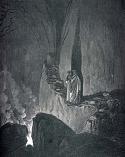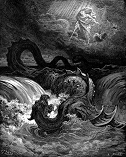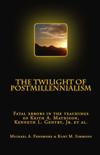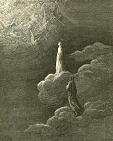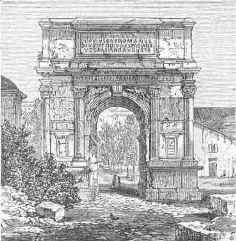 |
THE PRÆTERIST INTERPRETATIONFrederic W. Farrar (c.1831-1903) ; D.D., F.R.S. From The Early Days of Christianity “It has been usual to say that the Spanish Jesuit Alcasar.. was the founder of the Præterist School...But to me it seems that the founder of the Præterist School is none other than St. John himself.” |
There have been three great schools of Apocalyptic interpretation :- 1. The Præterists, who regard the book as having been mainly fulfilled. 2. The Futurists, who refer it to events which are still wholly future. 3. The Continuous-Historical Interpreters, who see in it an outline of Christian history from the days of St. John down to the End of all things. The second of these schools -- the Futurists -- has always been numerically small, and at present may be said to be non-existent.
The school of Historical Interpreters was founded by the Abbot Joachim early in the 13th century, and was specially flourishing in the first fifty years of the present century. [There are two school of the interpreters who make the Apocalypse a prophecy of all Christian history. The school of Bengel, Vitringo, Elliot, &c., make it mainly a history of the Church. Another school regards it more generally, and less specifically, as an outline of Epochs of the History of the world and the great forces which shape it into a Kingdom of God. To this latter school belong Hengstengerb, Ebrard, Auberlen, &c.]
The views of the Præterists have been adopted, with various shades of modification, by Grotius, Hammond, Le Clerc, Bousset, Eichorn, Hug, Wetstein, Ewald, Herder, Zullig, Bleek, DeWette, Lucke, Moses Stuart Davidson, Volkmar, Krenkel, Dusterdieck, Renan, and almost the whole school of modern German critics and interpreters. It has been usual to say that the Spanish Jesuit Alcasar, in his Vestigatio arcani sensus in Apocalpysi (1614), was the founder of the Præterist School, and it certainly seems as if to him must be assigned the credit of having first clearly enunciated the natural view that the Apocalypse, like all other known Apocalypses of the time, describes events nearly contemporaneous, and is meant to shadow forth the triumph of the Church in the struggle first with Judaism and then with Heathendom. But to me it seems that the founder of the Præterist School is none other than St. John himself. For he records the Christ as saying to him when he was in the Spirit, "Write the things which thou sawest, and THE THINGS WHICH ARE, and the things which are about to happen after these things." No language surely could more clearly define the bearing of the Apocalypse. It is meant to describe the contemporary state of things in the Church and the world, and the events which were to follow in immediate sequence. If the Historical School can strain the latter words into an indication that we are (contrary to all analogy) to have a symbolic and unintelligible sketch of many centuries, the Præterist School may at any rate apply these words, "THE THINGS WHICH ARE," to vindicate the application of a large part of the Apocalypse to events nearly contemporary, while they also give the natural meaning to the subsequent clause by understanding it of events which were then on the horizon. The Seer emphatically says that the future events which he has to foreshadow will occur speedily [Compare Tachu (Rev. 22. 5,16 ; iii.11; xi.14 ; xxii.20). It is curious to see with what extraordinary ease commentators explain the perfect simple and ambiguous expression "speedily" to mean any length of time which they may choose to demand. The word "immediately," in Matt. xxiv.29, has been subject to similar handling, in which indeed all Scripture exegesis abounds. The failure to see that the Fall of Jerusalem and the end of the Mosaic Dispensation was a "Second Advent" -- and THE Second Advent contemplated in many of the New Testament prophecies -- has led to a multitude of errors..] and the recurrent burden of his whole book is the nearness of the Advent. Language is simply meaningless if it is to be so manipulated by every successive commentator as to make the words "speedily" and "near" to imply any number of centuries of delay. The Præterist method of interpretation does not, however, interfere with that view of prophecy which was so well defined by Dr. Arnold. This is the view of those who have been called the "spiritual" interpreters. It admits of the analogical application of prophecy to conditions which, in the cycles of history, bear a close resemblance to each other. It applies to all times the principles originally laid down with reference to events which were being then enacted, and starts with the axiom of Bacon, that divine prophecies have steps and grades of fulfillment through divers ages. [De Augment. Scient. ii.11.] All that is really valuable in the works of the Historical Interpreters may thus be retained. No importance can be attached to their limitation of particular symbols, but the better part of their labours may be accepted as an illustration of the manner in which the Apocalyptic symbols convey moral lessons which are applicable to the conditions of later times.
But, apart from St. John's own words, it cannot be conceded that the central conception of the Præterist exegesis is a mere novelty of the 17th century. On the contrary, we can trace from very early days the application of various visions to the early emperors of Pagan Rome. Thus Justin Martyr believed that the Antichrist would be a person who was close at hand, who would reign three and a half years. [Dial. c. Tryph. p. 250] Irenaeus also thought that Antichrist, as foreshadowed by the Wild Beast would be a man ; and that "the number of the Beast" resented Lateinos, "a Latin," [Iren. Haer. v. 25] Hippolytus compares the action of the False Prophet giving life to the Beast's image, to Augustus inspiring fresh force into the Roman Empire. [De Antichristo, p.6] Later on, I shall furnish abundant evidence that a tradition of the ancient Church identified Nero with the Antichrist, and expected his literal return, just as the Jews expected the literal return of the Prophet Elijah. St. Victorinus (about A.D.303) counts the five dead emperors from Galba, and supposes that, after Nerva, the Beast (whom he identifies with Nero) will be recalled to life. ["Bestia de septem est quoniam ante ipsos reges Nero regnavit."] St. Augustine mentions a similar opinion. [De Civ. Dei, xx.19] The Pseudo-Prochorus, writing on Rev. xvii. 10, says that the "one which is" is meant for Domition. Bishop Andreas in the fifth century, applies Rev. vi.12 to the siege of Jerusalem, and considers that Antichrist will be "as a king of the Romans." Bishop Arethas, on Rev. vii., implies that the Apocalypse was written before the Jewish War. The fragments of ancient comment which we possess cannot be said to have much intrinsic value ; but such as they are they suffice to prove that the tendency of modern exegesis approaches quite as nearly to the earliest traditions as that of the Historical School. It is a specially important fact that St Augustine, as well as many others, recognized the partially retrogressive and iterative character of the later visions, and thereby sanctioned one of the most important principles of modern interpretation. [Id. ib. 17.]
The internal evidence that the book was written before the Fall of Jerusalem has satisfied not only many Christian commentators, who are invidiously stigmatised as "rationalistic," but even such writers as Wetstein, Lucke, Neander, Stier, Auberlen, Ewald, Bleek, Gebhardt, Immer, Davidson, Dusterdieck, Moses Stuart, F.D. Maurice, the authro of "The Parousia," Dean Plumptree, the authors of the Protestanten-Bibel and multitudes of others no less entitled to the respect of all Christians.
If, however, the reads still looks with prejudice and suspicion on the only school of Apocalyptic exegesis with unites the suffrages of the most learned recent commentators in Germany, France, and England, I hardly know where he is to turn. The reason why the early date and mainly contemporary explanation of the book is daily winning fresh adherents among unbiased thinkers of every Church and school, is partly because it rests on so simple and secure a basis, and partly because no other can compete with it. It is indeed the only system which is built on the plain and repeated statements and indications of the Seer himself, and the corresponding events are so closely accordant with the symbols as to make it certain that this scheme of interpretation is the only one that can survive. A few specimens may suffice to show how completely other systems float in the air.
Let us suppose that the student has found out that in viii.13 the true reading is "a single eagle," not an angel ; but, whether eagle or angel, he wants to know what the symbol means. He turns to the commentators, and finds that it is explained to be the Holy Spirit j(Victorinus); or Pope Gregory the Great (Elliott); or St. John himself (DeLyra); or St. Paul (Zeger); or Christ himself (Wordsworth). The Præterists mostly take it to be simply an eagle, as the Scriptural type of carnage--the figure being suggested not by the resemblance of the word "woe!" ("ouai") to the eagle's screams, but by the use of the same symbol for the same purpose by our Lord in His discourse about the things to come. [Matt. xxiv.28.]
But this is nothing! The student wishes to learn what is meant by the star fallen from heaven, in ix.1. The Historical school will leave him to choose between an evil spirit (Alford); a Christian heretic (Wordsworth); the Emperor Valens (DeLyra); Mohammed (Elliott); and, among others, Napoleon (Hengstenberg)!
The confusion deepens as we advance. The locusts are "heretics" (Bede); or Goths (Vitringa); or Vandals (Aureolus); or Saracens (Mede); or the mendicant orders (Brightman); or the Jesuits (Scherzer); or Protestants (Bellarmine).
The same endless and aimless diversity reigns throughout the entire works of the Historical interpreters ; none of them seems to satisfy any one but himself. The elaborate anti-papal interpretation of Elliott--of which (to show that I am far from prejudiced) I may mention, in passing, that I made a careful study and a full abstract when I was seventeen years old-- is all but forgotten. Mr. Faber admits that there is not the least agreement as to the first four trumpets among writers of his school, and he rightly says that "so curious a circumstance may well be deemed the opprobrium of Apocalyptic interpretation, and may naturally lead us to suspect that the true key to the distinct application of the first four trumpets has never yet been found."
Not that this school leave us any better off when we come to the seven thunders. They are seven unknown oracles (Mede); or events (Ebrard); or the seven crusades (Vitringa); or the seven Protestant kingdoms (Dunbar); or the Papal Bull against Luther (Elliott.
The two wings of the great eagle in xii.14 are the two Testaments (Wordsworth); or the eastern and western divisions of the empire (Mede, Auberlen); or the Emperor Theodosius (Elliott).
The Number of the Beast -- which may be now regarded as certainly intended to stand for Nero -- has been made to server for Genseric, Benedict, Trajan, Paul V., Calvin, Luther, Mohammed, Napoleon -- not to mention a host of other interpretations which no one has ever accepted except their authors. [The majority of guesses which have the least seriousness in them point to Rome, the Roman Empire, or the Roman Emperor.]
It is needless to multiply further instances. They might be multiplied almost indefinitely, but their multiplicity is not so decisive of the futility of the principles on which they are selected, as is the diversity of results which are wider than the poles asunder. What are we to say of methods which leave us to choose between the applicability of a symbol to the Holy Spirit or to Pope Gregory, to the Two Testaments or to the Emperor Theodosius? Anyone, on the other hand, who accepts the Præterist system finds a wide and increasing consensus among competent enquirers of all nations, and can see an explanation of the book which is simple, natural, and noble -- one which closely follows its own indications, and accords with those to be found throughout the New Testament. He sees that events, mainly contemporary, provide an interpretation clear in its outlines, though necessarily uncertain in minor details.
It he takes the view of the Spiritualists, he may at his pleasure make the symbols mean anything in general and nothing in particular.
If he is of the Historical School he must let the currents of Gieseler or Gibbon sweep him hither and thither at the will of the particular commentator in whom he for the time may chance to confide.
But if he follows the guidance of a more reasonable exegesis, he may advance with a sure step along a path which becomes clearer with every fresh discovery.
To receive Kurt Simmons’ e-mail newsletter, The Sword & The Plow, click the Subscribe link:
All rights reserved.
